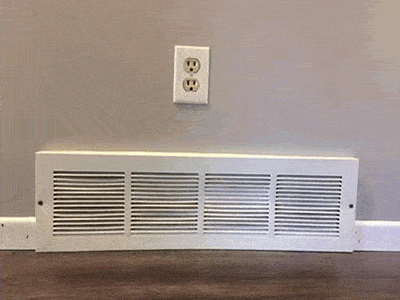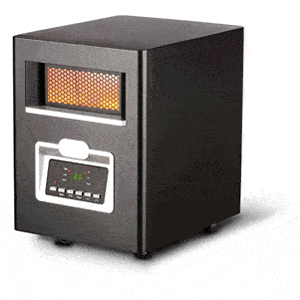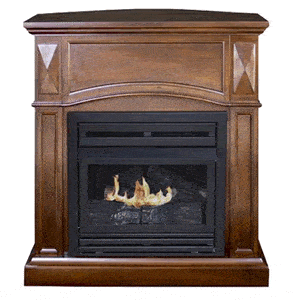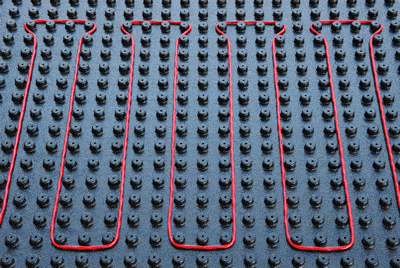As a homeowner, you want to make sure that you are efficiently heating your basement the best possible way that you can, and that you are not spending a fortune at the same time.
I want to share with you below the information that I was able to find out to help me heat my basement the most efficient and cost-effective way possible.
Is It Efficient To Heat Your Basement?
You might be surprised to learn, but it will save you money if you were to heat your basement. I know that sounds odd but let me explain how it works. When your basement is cold, that cold air will cause some heat to escape through water lines and ductwork, and then begin to pull in more cold air from outside through ducts that are not properly insulated.
That extra cold air being sucked in will then make your basement even colder, resulting in the upstairs temperatures to drop. When that happens, it will cause you to increase the temperature on the thermostat, which will make the furnace run longer and harder. All of that extra work on the furnace will result in a higher utility bill at the end of the month.
So as you can see it doesn’t matter if you use your basement for anything other than storing the Christmas decorations, the bottom line is that you can save money by keeping it warm.
How Can I Heat My Basement Efficiently?
It doesn’t matter if you have a finished basement, partially finished, or an unfinished basement, if you are going to heat it, you want to do it the most efficient and cost saving way that you can. I’ve gone through a list some of the best ways that you can heat your basement without burning a hole in your wallet each month.
#1 – Extend Ductwork and Install Cold Air Return
 Often when a basement is equipped with an HVAC heating system, the hot air registers are located on the ceiling of the basement. The problem with this is that a cold air return often gets overlooked. When the hot air is coming out of the registers, it’ll come down and then float back up to the upper half of the room, because heat rises. That will leave the bottom half of the room cooler, and often cold as you get closer to the floor.
Often when a basement is equipped with an HVAC heating system, the hot air registers are located on the ceiling of the basement. The problem with this is that a cold air return often gets overlooked. When the hot air is coming out of the registers, it’ll come down and then float back up to the upper half of the room, because heat rises. That will leave the bottom half of the room cooler, and often cold as you get closer to the floor.
By installing a cold air return in the basement, you can help remove the cold air that hangs out around the bottom half of the room and recycle it within the furnace to produce more hot air.
To find out how much it would cost to have a cold air return installed in your basement, you’ll have to call an HVAC technician to come out to your home and give you an estimate. If you call around, you should be able to find some companies that will come and give you a free estimate. The technician would have to come to your home because not every basement is the same, and every furnace/venting system is set up differently. To try and figure it out over the phone would be hard to do.
#2 – Electric Space Heater
 Electric space heaters are a cheap upfront cost that could adequately provide enough heat to warm up your cold basement. With many different types and styles to choose from, you shouldn’t have a problem finding one that will suit your needs. You should be able to find one within $50 to $100 that will do a nice job.
Electric space heaters are a cheap upfront cost that could adequately provide enough heat to warm up your cold basement. With many different types and styles to choose from, you shouldn’t have a problem finding one that will suit your needs. You should be able to find one within $50 to $100 that will do a nice job.
To determine how much it will cost each month to run an electric space heater in your basement will depend on two factors. First, how many watts does the space heater use, and second, how much do you pay for electricity where you live.
Most electric heaters use about 1,500 watts, although depending on the make, model, and size, this number could be slightly higher or lower. For this example, we’ll assume it’s only using 1,500 watts. But because the electric bill is charged based on kilowatts and not watts you’ll have to convert the watts over to kilowatts. 1,000 watts is the same as 1 kilowatt, so this means the space heater is using 1.5 kilowatts of electricity.
If your space heater were running for 8 hours per day, you would first multiply the watts (1,500) by the number of hours (8).
1,500 x 8 = 12,000
Next, divide this number by 1,000 to get the kilowatts.
12,000 / 1,000 = 12
Once you have the kilowatts used in an hour, you will multiply that number by how much your utility company charges for electricity.
The cost of electricity varies from State to State. For example, some States pay as little as 9.03 cents per kilowatt-hour (KWH), while others pay as much as 33.57 per kilowatt hour (KWH). The average cost of electricity in the USA is 13 cents per kilowatt hour (KWH). You can check your utility bill to determine exactly how much they charge you for electricity.
In this example, let’s assume you pay $0.13 per kilowatt.
12 x $0.13 = $1.56
Now this will tell you how much you are going to pay each day that you have the electric space heater running (during 8 hours).
#3 – Natural Gas Fireplaces
 A gas fireplace not only looks nice but it’s much cleaner and more energy efficient than a wood burning fireplace.
A gas fireplace not only looks nice but it’s much cleaner and more energy efficient than a wood burning fireplace.
A standard gas fireplace has a BTU rating of between 25,000 to 40,000 BTUs/hr. This would be big enough to heat your basement with roughly 70 – 85 percent efficiency.
There are different styles and types of gas fireplaces to choose from:
Inserts: This type of fireplace will go inside of an existing cavity from a wood fireplace.
Built-in or Standalone: This is where you will build in a fireplace where there isn’t space already.
With each type of fireplace, you can choose between different models that vent to the outside, or a vent-free that vents within the home were to retain more of the heat.
Vented: A vented fireplace is a two-pipe system, better known as a direct vent, where the vents exit your home from an exterior wall. One of the pipes will feed outside air for combustion to a sealed firebox, while the other pipe removes the combustion fumes. These types of fireplaces can be 70 to 85 percent energy efficient.
Vent-Free: A vent-free fireplace can be mounted to any wall, including an interior wall, as long as you can get a natural gas line to it. This type of fireplace can get to 99 percent energy efficiency because all of the heat stays in the room.
The downside with a vent-free model is that they eat up the oxygen in the room, and that is why they have a built-in oxygen-depletion sensor that will automatically shut off the unit if the oxygen drops below 18 percent. Because of this, some U.S. states such as California have banned the vent-free units. Canada has also banned the vent-free systems from being sold. So keep that in mind when you are looking.
How many BTUs do I need?
While looking for a fireplace, it is important to figure out how many square feet you need to heat, so you don’t end up buying one that won’t be able to heat the space properly. Below is an idea of how many BTU you will require to heat your space.
| BTUs | Space to be heated |
| 14,000 – 20,000 | 400 – 700 square feet |
| 19,000 – 30,000 | 700 – 1,100 square feet |
| 21,000 – 40,000 | 800 – 1,300 square feet |
| 26,000 – 50,000 | 1,300 – 2,100 square feet |
| 30,000 – 54,000 | 1,500 – 2,500 square feet |
| 36,000 – 65,000 | 1,900 – 3,000 square feet |
Here is a very helpful BTU calculator that can help you figure out how many BTUs you are going to need based on your square footed area.
How much will you spend?
Depending on how many BTU you require, and how well insulated your home is, will both determine how much you will end up paying for a natural gas fireplace. Ultimately, you can expect to pay anywhere between $2,000 to $5,500 installed.
The average cost in the U.S. to run a gas fireplace with gas logs is roughly $6.33 per month.
#4 – Radiant Floor Heating
Radiant floor heating is a great way to heat your basement. It is quiet, comfortable and best of all, energy efficient. There are two different types of radiant floor heating available for residential use: electric radiant heating, and hydronic radiant heating (hot water).
Electric Radiant Floor Heating
 Electric radiant heating can be installed at any time in the home, and it’s a fairly easy enough project for the DIYers out there.
Electric radiant heating can be installed at any time in the home, and it’s a fairly easy enough project for the DIYers out there.
Installing radiant floor heating throughout your basement could be a little costly upfront. For example, a safe estimation on the flooring materials alone could run you between $10 to $20 per square foot depending on the system you go with.
To calculate the square footage of your basement, you can multiply the length by the width of the room(s) and then multiply that number by the cost of material per square foot. For example a room that measures 12.5′ long, by 20′ wide (12.5 x 20 = 250), multiplied by $10.00 (per square foot), equals $2,500 in material needed.
Next, you’ll need an electrician for a couple of hours and depending on where you live and who you hire, you could be looking at an additional $250 to $500.
Now, what does it cost to run an electric radiant heater for 24 hours? To help determine how much it will cost, we can turn to Warmup, who is one of the largest manufactures of electric radiant floor heaters in the USA. Based on a basement that is 250 square feet, and using the average cost per kilowatt of $0.13, we can see that it will cost roughly $4.18 per day.
Try the cost calculator based on your square footage and cost of hydro.
Hydronic Radiant Floor Heating
 A hydronic radiant floor heating is going to be much more money up front then the electric radiant floor heater but will cost less to operate over the long run.
A hydronic radiant floor heating is going to be much more money up front then the electric radiant floor heater but will cost less to operate over the long run.
Ideally, to help save you money on the install, a hydronic radiant heating system should typically be installed during the construction of the home, although you could add it later on it will cost you a little more.
The way a hydronic system works is that it uses a hot water supply such as a boiler or water heater to pump hot water through pipes that are installed and laid out under the floor. The water is heated between 100 to 120 degrees Fahrenheit.
To heat a larger room such as a basement, you will need to install a separate water heater which could cost anywhere from $500 to $2,500 depending on how many gallons you’ll need it to hold, and who does the install for you.
A boiler is typically only used when you are dealing with a much larger square footage area such as an entire home or in a commercial building.
The cost for material can set you back anywhere between $7 to $18 per square foot. As well the cost of a pump that is used to circulate the water, which could cost between $800 to $1,700.
You will have an extra water heater to run, but it shouldn’t run as much as your current water heater so it might only cost about half of what you are paying now for heating the water tank.
#5 – Baseboard Heaters
 Although baseboard heaters have a 100 percent energy efficiency rating, they are one of the more expensive ways to heat your home each month. Although they are relatively inexpensive to buy and install, costing only a few hundred dollars, they will use up a lot of electricity resulting in a much higher utility bill at the end of the month.
Although baseboard heaters have a 100 percent energy efficiency rating, they are one of the more expensive ways to heat your home each month. Although they are relatively inexpensive to buy and install, costing only a few hundred dollars, they will use up a lot of electricity resulting in a much higher utility bill at the end of the month.
A typical 5-foot electric baseboard heater will cost between $100 – $200 to buy and typically cost between $50 – $200 to have installed. Depending on where you live and how much you pay for electricity, that same 5-foot electric baseboard heater will then cost roughly an additional $120 – $160 per month to have running every month
The US Department of Energy has said that baseboard heaters have one of the lowest upfront costs, but they are one of the most expensive options for heating your home over the long term.
